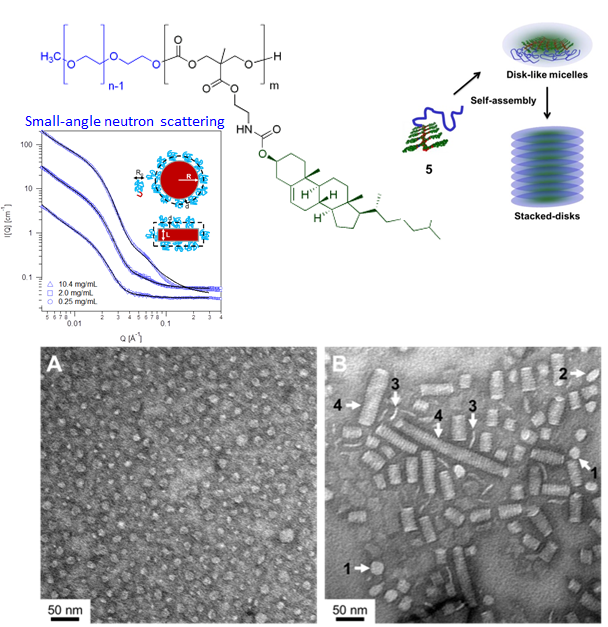Fundamentals of Macromolecular Self Assembly: particles, gels, and polyelectrolyte complex coacervates
Summary
Synthetic biomaterials must pass rigorous clinical, toxicological, and regulatory tests before they are introduced into practice. In order to design new materials with specialized properties (size and shape, viscosity, elastic modulus, drug loading capacity for example) an improved set of measurement methods and test of modern theory and simulations are required to develop structure-property guidelines. This research involves experimental studies of macromolecules with novel chain architectures for their characterization of solution self-assembled structure and transport properties in multi-component solutions. Of particular interest are two types of self-assembling materials, oppositely charged ion-containing polymers and amphiphilic polymers.
Description
This project considers the hierarchical structure formed in aqueous solution from rationally‑designed block polymer sequence and chemistry. Regular nanoscale structures spontaneously form in aqueous solution by tailoring the antagonistic interactions among the solution and copolymer moieties. These structures, however, can display a hierarchy at multiple length scales, therefore making characterization a challenge. Further, experimentally, it is demonstrated that monomer-level modifications induce larger scale structure changes. This is a general outcome facing modern tailored materials, thereby increasing the need for a rapid materials property-space searches.
Amphiphilic Polymers : in collaboration with IBM and IBN
Block copolymer amphiphiles are larger-scale analogues to surfactants that have a hydrophilic head group and hydrophobic tail. However, polymer-based amphiphiles have an advantage of designed molecular weight, block asymmetry, and relative solubility. Further, by incorporating biomimetic and specific functional groups, the molecular-scale ordering can lead to novel morphologies (Figure 1). Further by considering the multi-block structure one may design materials that span nanoparticles, gels, and ordered solutions that would serve different purpose in biomaterials design.

Figure 1. Adapted from S. Venkataraman et al. Macromolecules 46, 4839 (2013)
Block Polyelectrolytes : In collaboration with CHiMaD
Complex coacervates are hierarchical structured materials formed by oppositely charged polymers. These ion-containing multi-block polymer complexes form materials that span discrete nanoscale objects, solid-liquid two-phase systems, microphase-ordered viscoelastic solids, and gels. The hierarchically-structured materials have a vast materials property phase-space controlled not only by the polymer parameters, but the solution conditions, and non-equilibrium mixing conditions. Due to the long-ranged and strong electrostatic interactions, combined with block copolymer microstructure, these materials represent a challenge in polymer physics, both experiment and simulation. This project shall provide quantitative unique experimental data to test predictions and identify missing molecular-mesoscale structure information for challenging model systems. It is a goal to cooperate to develop and advance simulation methods and models toward predictive material properties to accelerate in silico materials discovery.
Major Accomplishments
- International Scientific Symposium (Completed)
- Multivalent Interactions in Polyelectrolytes: New Physics, Biology and Materials
- October 2-4, 2015, Eckhardt Research Center, 5640 South Ellis Avenue, Chicago, IL 60637
- Center for Hierarchical Materials Design (CHiMaD), Institute for Molecular Engineering, University of Chicago
- Publications
- S Srivastava, M Andreev, AE Levi, DJ Goldfeld, J Mao, WT Heller, VM Prabhu, JJ de Pablo and MV Tirrell. Gel phase formation in dilute triblock copolyelectrolyte complexes, Nature Communications DOI: 10.1038/ncomms14131 (2017).
- GM Wei, S Venkataraman, JL Hedrick, YY Yang and VM Prabhu, Self-Assembly and Dynamics Driven by oligocarbonate− Fluorene End-Functionalized Poly(ethylene glycol) ABA Triblock Copolymers, Macromolecules, 50, 1090 (2017).
- V.M. Prabhu et al. “Equilibrium self-assembly, structure and dynamics of clusters of star-like micelles,” ACS Macro Letters, 4, 1128 (2015).
- V.M. Prabhu et al. “Star-like structure of oligocarbonate-fluorene end-functionalized poly(ethylene glycol) ABA triblock copolymers below the gel point.” Macromolecular Symposia, 358, 157(2015).
- Invited Presentations
- 4/2017 ACS National Meeting, ACS Polymer Chemistry Award Symposia in Honor of Professor M. Muthukumar, San Francisco, CA.
- 2/2016. Gordon Research Conference on Colloidal, Macromolecular and Polyelectrolyte Solutions.
- 12/2015. PacificChem. Section on New perspectives of synthetic and biological soft matter
- 11/2015. University of Massachusetts-Amherst, Polymer Science and Engineering Colloquium.
- 9/2015. Workshop on Structure and Dynamics in Soft Matter Systems at Oak Ridge National Laboratory
- 5/2015. Future and Current Use of Neutron Spin-Echo Spectroscopy in Condensed Matter Research Workshop at Oak Ridge National Laboratory.

